#2022 victoria floods
Explore tagged Tumblr posts
Text
Enormous floods have once again engulfed much of South Sudan, as record water levels in Lake Victoria flow downstream through the Nile. More than 700,000 people have been affected. Hundreds of thousands of people there were already forced from their homes by huge floods a few years ago and were yet to return before this new threat emerged.
Now, there are concerns that these displaced communities may never be able to return to their lands. While weather extremes regularly displace whole communities in other parts of the world, this could be the first permanent mass displacement due to climate change.
In the Sudd region of South Sudan, the Nile passes through a vast network of smaller rivers, swamps, and floodplains. It’s one of the world’s largest wetlands. Flood levels vary significantly from year to year, mostly caused by fluctuations in water levels in Lake Victoria and controlled releases from the dam in Uganda where the lake empties into the Nile.
The Sudd’s unique geography means that floods there are very different than elsewhere. Most floodwater cannot freely drain back into the main channel of the White Nile, and water struggles to infiltrate the floodplain’s clay and silt soil. This means flooding persists for a long time, often only receding as the water evaporates.
People Can No Longer Cope
The communities who live in the Sudd, including the Dinka, Nuer, Anyuak, and Shilluk, are well adapted to the usual ebb and flow of seasonal flooding. Herders move their cattle to higher ground as flood waters rise, while earthen walls made of compressed mud protect houses and infrastructure. During the flooding season, fishing sustains local communities. When floods subside, crops like groundnuts, okra, pumpkins, sorghum, and other vegetables are planted.
However, the record water levels and long duration of recent flooding have stretched these indigenous coping mechanisms. The protracted state of conflict in the country has further reduced their ability to cope. Community elders who spoke to our colleagues at the medical humanitarian aid charity Médecins Sans Frontières said that fear of conflict and violence inhibited them from moving to regions of safe ground they had found during a period of major flooding in the early 1960s.
Around 2.6 million people were displaced in South Sudan between 2020 and 2022 alone, a result of both conflict and violence (1 million) and flooding (1.5 million). In practice, the two are interlinked, as flooding has caused displaced herders to come into conflict with resident farmers over land.
Stagnant floodwater also leads to a rise in water-borne infections like cholera and hepatitis E, snakebites, and vector-borne diseases like malaria. As people become malnourished, these diseases become more dangerous. Malnutrition is already a big problem, especially for the 800,000 or so people who have fled into South Sudan from Sudan following the start of a separate conflict there in April 2023.
Many people are housed in internal displacement camps like at Bentiu, where close to 100,000 people reside. Bentiu is now an island in the floodwaters, protected by embankments that require continued maintenance. As such there are concerns about the long-term future and sustainability of the camp.
The new record levels in Lake Victoria this May raised the alarm over potential unprecedented flooding in the country this year. The two and a half months it takes for floodwaters to make their way downstream to South Sudan provides an early-warning system for communities and humanitarian agencies to prepare. However, forecast models are not able to accurately predict if the embankments at camps like Bentiu will hold.
Will People Ever Return?
Evacuating the camp may be inevitable, some say, because floods seem to be getting worse, likely linked to deforestation and anthropogenic climate change. However, while there is a clear upward trend to lake levels across East Africa, including Lake Victoria, this could also be due to the way water and land is being managed, as well as changes to precipitation.
Though there have been increases in the rainfall during the region’s short rains in October, November, and December, that’s balanced out by decreases in the rainfall season between March and May.
However, climate models indicate increases in precipitation in the catchment, as well as more frequent positive phases of the Indian Ocean Dipole (a weather phenomenon similar to El Niño in the Pacific), which caused the record rainfall in 2020 and 2023. With floods taking a long time to recede, even small increases in the frequency of these positive dipole phases, and small increases in rainfall, could lead to the Sudd wetlands growing—permanently.
Decisionmakers in a country affected by conflict are used to uncertain futures, but they will also need to consider a scenario in which an irreversible expansion of the Sudd wetlands could make the displacement permanent. Where these communities could be relocated is another question entirely.
10 notes
·
View notes
Text
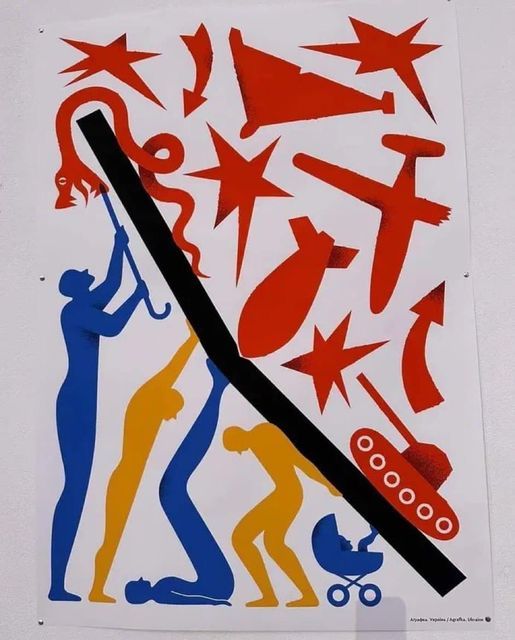
A Poster from the Kyiv Book Fair, 2023.
* * * * *
Victoria Amelina was a Ukrainian novelist, poet and public intellectual. When Russia launched its full-scale invasion of her country in 2022, she set aside most of her writing to document and research war crimes. Amelina understood the risks she ran with this work, both as a citizen who chose to stay in her country during war, and as a writer facing an invading army bent on destroying Ukrainian national identity. She moved her son to safety in Poland, but kept returning herself. When Kyiv came under bombardment in early summer she watched the explosions from her apartment and wrote: “The war is when you can no longer follow all news and cry about all neighbours who died instead of you a couple of miles away. Still, I want to not forget to learn the names.” She died on 1 July, aged 37, from injuries sustained in a Russian missile strike on a pizza restaurant in the eastern town of Kramatorsk. Two weeks before she died, she wrote about a painter, Polina Rayko, whose work had been largely obliterated in the floods unleashed by the collapse of the Kakhovka dam: “Art lives as long as the world sees it.” Below is Poem About a Crow, inspired by her work interviewing women who lived through Russian occupation. Translated by Uilleam Blacker.
Poem About a Crow
In a barren springtime field Stands a woman dressed in black Crying her sisters’ names Like a bird in the empty sky She’ll cry them all out of herself
The one that flew away too soon The one that had begged to die The one that couldn’t stop death The one that has not stopped waiting
The one that has not stopped believing The one that still grieves in silence
She’ll cry them all into the ground As though sowing the field with pain
And from pain and the names of women Her new sisters will grow from the earth And again will sing joyfully of life
But what about her, the crow?
She will stay in this field forever Because only this cry of hers Holds all those swallows in the air
Do you hear how she calls Each one by her name?
[The Guardian]
24 notes
·
View notes
Text
Victoria Amelina was a Ukrainian novelist, poet and public intellectual. When Russia launched its full-scale invasion of her country in 2022, she set aside most of her writing to document and research war crimes.
Amelina understood the risks she ran with this work, both as a citizen who chose to stay in her country during war, and as a writer facing an invading army bent on destroying Ukrainian national identity.
She moved her son to safety in Poland, but kept returning herself. When Kyiv came under bombardment in early summer she watched the explosions from her apartment and wrote: “The war is when you can no longer follow all news and cry about all neighbours who died instead of you a couple of miles away. Still, I want to not forget to learn the names.”
She died on 1 July, aged 37, from injuries sustained in a Russian missile strike on a pizza restaurant in the eastern town of Kramatorsk.
Two weeks before she died, she wrote about a painter, Polina Rayko, whose work had been largely obliterated in the floods unleashed by the collapse of the Kakhovka dam: “Art lives as long as the world sees it.”
Below is Poem About a Crow, inspired by her work interviewing women who lived through Russian occupation. Translated by Uilleam Blacker.
Poem About a Crow
In a barren springtime field
Stands a woman dressed in black
Crying her sisters’ names
Like a bird in the empty sky
She’ll cry them all out of herself
The one that flew away too soon
The one that had begged to die
The one that couldn’t stop death
The one that has not stopped waiting
The one that has not stopped believing
The one that still grieves in silence
She’ll cry them all into the ground
As though sowing the field with pain
And from pain and the names of women
Her new sisters will grow from the earth
And again will sing joyfully of life
But what about her, the crow?
She will stay in this field forever
Because only this cry of hers
Holds all those swallows in the air
Do you hear how she calls
Each one by her name?
11 notes
·
View notes
Text
These Mighty Pyramids Were Built By One of Africa’s Earliest Civilisations! The Mysterious Rulers of Nubia, in Present-day Sudan, Erected Hundreds of Tombs and Temples that Rival Cairo’s.
— By Emma Thompson | 29 December 2022 | Photographs By: Nichole Sobecki

A “haboob” (sandstorm) rolls across the Meroë pyramids in Sudan. Most of the 41 tombs here belong to the royals of the powerful Kingdom of Kush (900 B.C. to A.D. 400), which ruled large parts of the middle Nile Valley.
Powered by agriculture, ancient Sudan’s great civilisations thrived and erected mighty temples and tombs honouring their gods, kings, queens, and nobles. Their building boom left behind some 255 pyramids—more than twice the number Egypt constructed next door.
Yet few Western travellers have seen these hulking sandstone relics. That’s because Sudan’s tourism industry has been impeded by two civil wars (1956-1972 and 1983-2005) and the battle for independence that led to the creation of South Sudan in 2011.
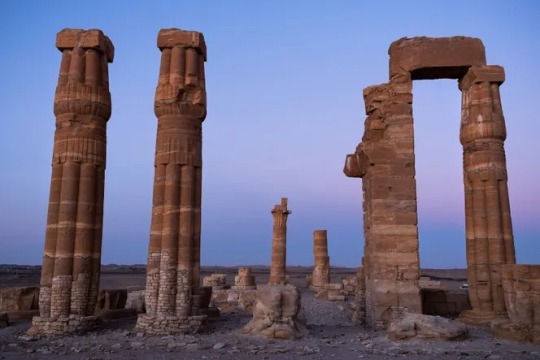
The temple of Soleb was built in the 14th century B.C. by Pharaoh Amenhotep III, in present-day Sudan. Visitors can still view its massive columns and splendid relief carvings.
Travel to Sudan is still currently not advised due to ongoing civil unrest related to a 2021 coup. However, when tensions ease, Sudan offers a singular chance to camp beside crowd-free ancient pyramids and to learn about the mysterious reign of these little-known pharaohs. A guided road trip along the Nile Valley takes you from the splendid temple at Soleb to the UNESCO-recognized Meroë, with the world’s largest cache of pyramids.
Black Pharaohs and a Once Great City
Nubia once stretched south from Aswan, Egypt, to modern-day Khartoum, Sudan. It gave rise to one of Africa’s earliest civilisations, the Kingdom of Kush, whose kings—nicknamed the Black Pharaohs—conquered Egypt in 747 B.C. and ruled the vast territory for nearly a century.
This drama played out on the banks of the world’s longest river, the Nile. Flowing south to north from Lake Victoria to the Mediterranean, the legendary waterway was considered the source of life itself because the annual flooding brought fertile soil for farming.
From the capital of Khartoum, it’s a nine-hour drive north to Soleb, Sudan’s best-preserved temple and the southernmost structure built by Amenhotep III, the Egyptian pharaoh who also commissioned the temples at Luxor. It was once guarded by the Prudhoe Lions, a pair of finely carved red granite beasts inscribed by the boy-king Tutankhamun when he visited. They are now displayed at London’s British Museum.
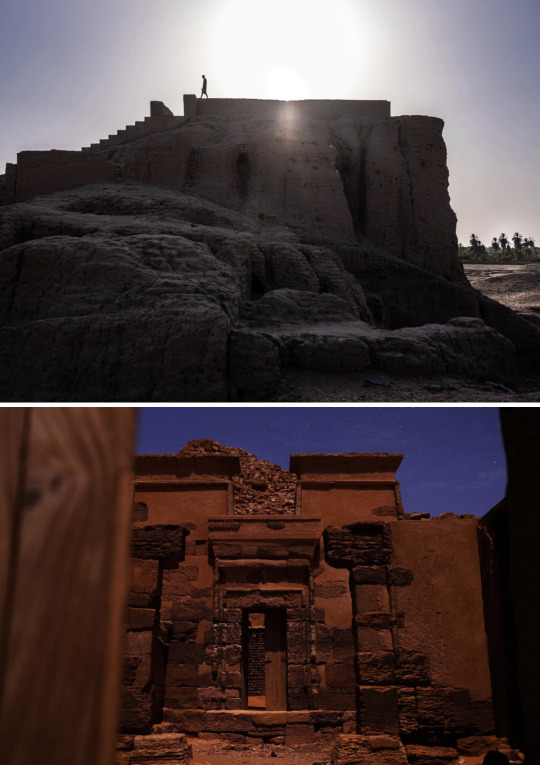
Top: Visitor Nadeem Abduraziq Mohammed walks through the ancient city of Kerma, Sudan, in July 2021. Kerma has been occupied for at least 8,000 to 10,000 years, reaching its peak around 1800 B.C., when it was capital of the Kingdom of Kush. Bottom: There are 41 tombs in Meroë’s north cemetery, 38 of them belonging to monarchs who ruled the region between B.C. 250 and A.D. 320.
Take a small barge from the village of Wawa to the western bank of the Nile, and you soon see the sandstone columns of Soleb’s main hall. Carved at their bases are images of Assyrians, hands chained behind their backs, whom the Black Pharaohs took as prisoners of war.
A few miles south of Soleb, set back from the tents where locals serve small glasses of tea beside the Nile, is Kerma. Established around 5,500 years ago, this ancient capital grew up around a huge adobe temple called the Western Defuffa. At its height the city had a population of 10,000; today, its mud brick ruins are inhabited only by nesting swallows. Nearby lies one of the oldest cemeteries in Africa.
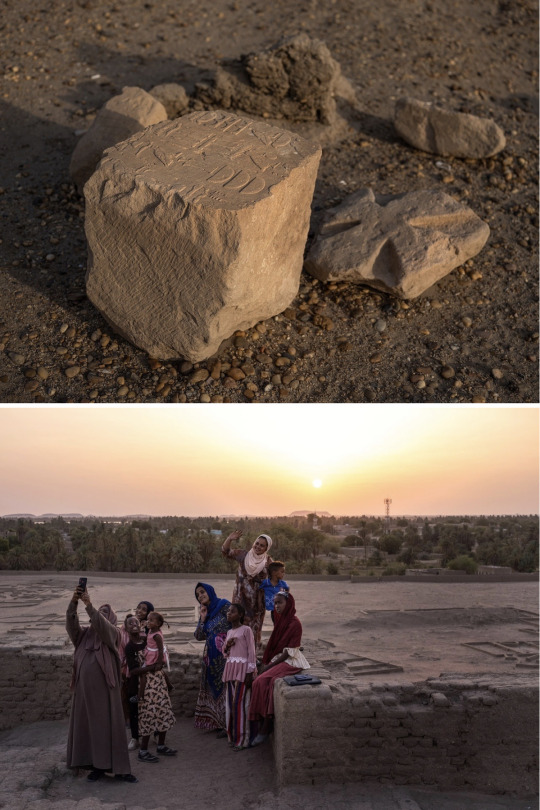
Top: A fragment of an ancient carving sits near the Kerma necropolis. This area of Sudan has been inhabited since Paleolithic times. Bottom: Tahani Abdulaziz takes a photograph of family members during a visit to Kerma.
Haunting Tombs and Dazzling Murals
Just over an hour’s drive south, and slowly being swallowed by sand, is Old Dongola. Founded with a fortress in A.D. 600, it served as the capital of the medieval Nubian kingdom of Makuria and grew to include palaces, houses, and Christian churches. It was a major stop on the Darb al-Arba’in (Forty Days Road) that thousands of camel caravans followed, transporting ivory and slaves between the Sudanese town of Darfur and Egypt.
Best preserved is the Church of the Old Granite Columns, its pale pillars framing a Throne Hall that was converted into a mosque in 1317 and remained in use until 1969. Now it’s open to visitors, along with an adjacent Islamic graveyard with distinctive 17th-century domed tombs known as qubbas.
From there, the Nile loops eastward and you come to El-Kurru, a cemetery used by the royal family of the Kingdom of Kush. Unlike in Egypt, Nubian burial chambers sit below the pyramids, not inside them.
Adobe tunnels cover the entrances to the chambers, chief among them the tomb of King Tanutamun (who died around 653 B.C.). Uneven shallow steps descend into the darkness until a flashlight click reveals a duo of domed rooms, one leading onto the other. Their white gypsum walls are covered with intricate murals in colours of ochre and yellow.
On the back wall is an arresting scene depicting Tanutamun’s heart being weighed against a feather by Maat, the goddess of truth. Kushites believed this recorded a person’s good and bad deeds and determined if the king’s soul could pass into paradise.
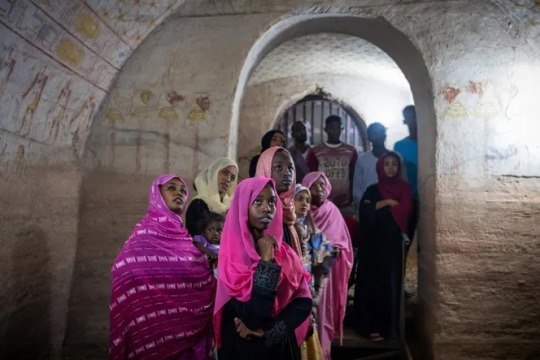
A Sudanese family tours El Kurru, a field of pyramids built for the kings and queens of ancient Kush.
More royal tombs crop up in Nuri, further upstream. Its smaller and steeper 70-plus pyramids are now reduced to 20. The most famous tombs belong to King Taharqa, the Black Pharoah who conquered Egypt, and King Nastasen, which archaeologists have to scuba-dive to reach because of rising ground waters.
Nuri served as the royal necropolis for the adjacent town of Napata, the first capital of the Kingdom of Kush. Both the cemetery and the ruins of the settlement lie across the Nile from Jebel Barkal, a 341-foot-tall sandstone mesa. From its summit, you can see the ruins of Nuri, including rows of cracked pillars and pairs of giant stone rams, their eyes and ears worn away by time.
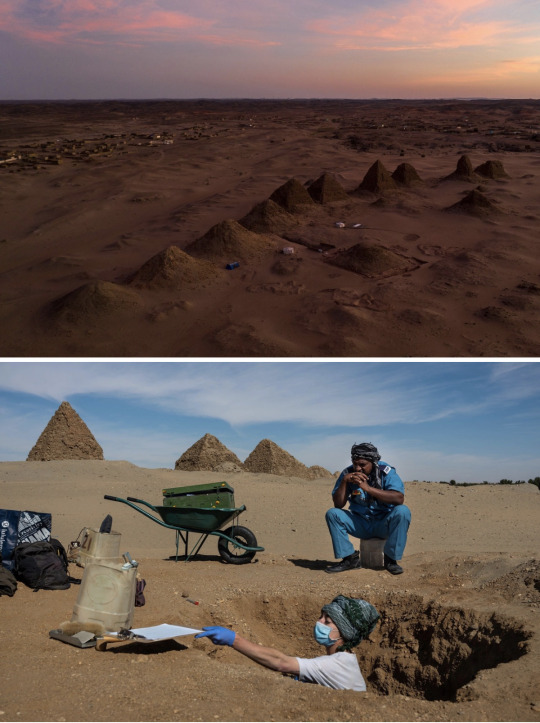
Top: The pyramids of Nuri, Sudan, were built between 650 and 300 B.C. The most famous tomb belongs to King Taharqa, the Black Pharaoh who conquered Egypt. Bottom: Archaeologist Gretchen Emma Zoeller excavates a burial site in Nuri. The ancient site sprawls across more than 170 acres along the Nile in northern Sudan.
On the western side of Jebel Barkal is a crumbling stone door frame leading to the Temple of Mut, wife of Amun. Spotlights illuminate its fine wall murals chronicling Taharqa’s coronation in white clay, ocher, and deep blue.
The World’s Largest Group of Pyramids
Finally, the Nile weaves past Meroë (pronounced Mero-way), the Kushite capital until the empire collapsed in A.D. 400 and site of Sudan’s best-preserved pyramids. More than 200 of them spread across the sands. Their granite and sandstone bases are etched with elephant, giraffe, and gazelle designs, proof that this was once fertile grasslands.

Sudanese tourists visit Jebel Barkal, Sudan, to climb the small butte, which has been considered sacred for thousands of years. Roughly a dozen pyramids are also scattered around the base of the mountain.
“It’s the biggest congregation of pyramids in the world,” reports archaeologist and Meroë site manager, Mahmoud Suliman. “At the time of the 2019 revolution, street signs, advertisements, and paintings all featured their images. It brought people together because the pyramids are so tied to our sense of identity.”
Mentioned in the writings of Herodotus, there’s an air of defiance about these structures that stand firm against the sands trying to swallow them. Indeed, it was an act of resistance that led to their construction in the first place. In the third century B.C., Kushite King Arakamani (Ergamenes) had grown tired of the Meroitic (Meroë-led) kingdom’s power-hungry high priests. So when they sent an order for him to commit suicide, he responded by having them all murdered instead.
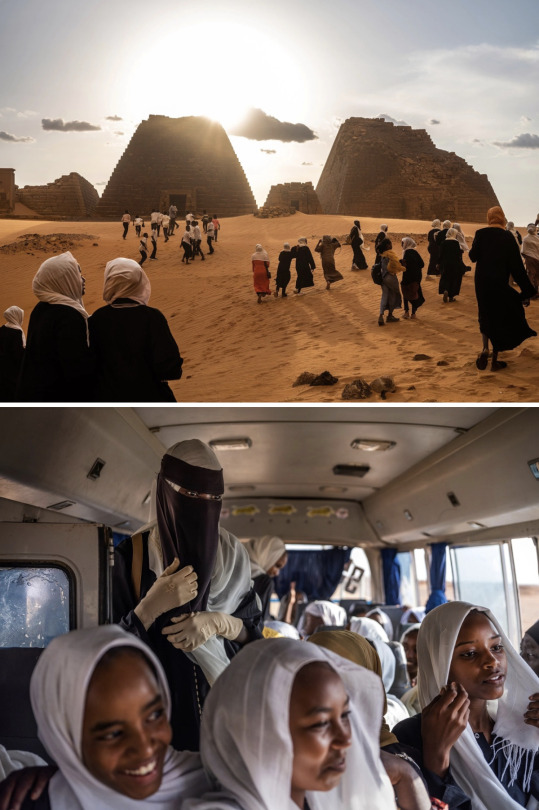
Top: A group of school children approach the pyramids at Meroë. Bottom: Volunteer tour guides show a group of Sudanese school children the Meröe pyramids. During the dictatorship of Omar al-Bashir from 1989 to 2019, Sudan’s school curriculum was infused with Islamic ideology and much of its rich ancient history was glossed over, but the new government wants to change that.
The rebellion ushered in a new era of culture: the almighty Egyptian god Amun-Ra was downgraded in favour of the lion god Abedemak, the (still undeciphered) Meroitic script was created, and warrior queens, known as kandakes, ruled the army. Inside the tombs, the carvings of the kings stand taller than the gods. You won’t see that in Egypt. Here, kings controlled everything except death.
It’s a strong message and one that’s inspired a fresh wave of national pride. For just as Ancient Greece informed so much of today’s European culture, so too did Nubia shape Sudan. It is the bedrock that formed the country’s sense of self and identity. Understanding this history suggests a way forward for Sudan.
“These were very popular kings and queens,” says Aya Allam, a Sudanese martial artist based in Khartoum. “They are a reminder that we were once a great nation and could become great once again.”
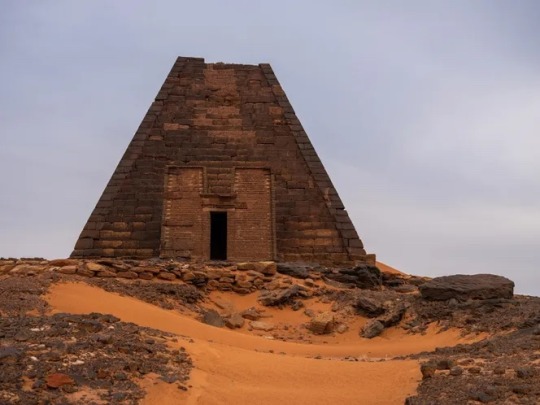
A pyramid covers a tomb in Meroë, Sudan. Rulers of the Kingdom of Kush were buried here underneath the steeply pitched structures, which range in height from 30 to one hundred feet tall, far shorter than the pyramids in nearby Egypt.
— Emma Thomson is a British Travel Writer. Nichole Sobecki is a Kenya-based Photographer.
#African Civilization#Mighty Pyramids#Mysterious Rulers#Sudan 🇸🇩#Tombs#Temples#Egypt 🇪🇬#Cairo#Emma Thompson#Nichole Sobecki#Black Pharaohs#Haunting Tombs | Dazzling Murals
3 notes
·
View notes
Text
Events 10.7 (after 1960)
1961 – A Douglas Dakota IV operated by Derby Aviation (later renamed to British Midland International) crashes in Canigou, France, killing 34 people. 1963 – President Kennedy signs the ratification of the Partial Nuclear Test Ban Treaty. 1963 – Buddhist crisis: Amid worsening relations, outspoken South Vietnamese First Lady Madame Ngo Dinh Nhu arrives in the US for a speaking tour, continuing a flurry of attacks on the Kennedy administration. 1977 – The Fourth Soviet Constitution is adopted. 1978 – Aeroflot Flight 1080 crashes after takeoff from Koltsovo International Airport, killing 38. 1979 – Swissair Flight 316 crashes at Ellinikon International Airport in Athens, Greece, killing 14. 1985 – The Mameyes landslide kills almost 200 people in Puerto Rico. 1985 – Four men from the Palestine Liberation Front hijack the MS Achille Lauro off the coast of Egypt. 1987 – Sikh nationalists declare the independence of Khalistan from India; it is not internationally recognized. 1988 – A hunter discovers three gray whales trapped under the ice near Alaska; the situation becomes a multinational effort to free the whales. 1991 – Croatian War of Independence: Bombing of the Banski Dvori in Zagreb, Croatia. 1993 – The flood of '93 ends at St. Louis, Missouri, 103 days after it began, as the Mississippi River falls below flood stage. 1996 – Fox News Channel begins broadcasting. 1998 – Matthew Shepard, a gay student at the University of Wyoming, is found tied to a fence after being savagely beaten by two young adults in Laramie, Wyoming. He dies five days later. 2000 – Israeli-Palestinian conflict: Hezbollah militants capture three Israeli Defense Force soldiers in a cross-border raid. 2001 – The U.S. invasion of Afghanistan begins with an air assault and covert operations on the ground, starting the longest war in American history. 2002 – The Space Shuttle Atlantis launches on STS-112 to continue assembly of the International Space Station. 2004 – Three bombs explode at Taba and Nuweiba in the Sinai Peninsula, Egypt, killing 34. 2008 – Asteroid 2008 TC3 impacts the Earth over Sudan, the first time an asteroid impact is detected prior to its entry into Earth's atmosphere. 2008 – Qantas Flight 72 experiences an in-flight upset near Learmonth, Victoria, Australia, injuring 112. 2016 – In the wake of Hurricane Matthew, the death toll rises to over 800. 2022 – 10 people die and 8 are injured in an explosion at petrol station in Creeslough. 2022 – Ales Bialiatski, along with two organisations, Memorial & Center for Civil Liberties, are awarded the Nobel Peace Prize. 2023 – Hamas and several other Palestinian terrorist groups launch an attack into Israel, which results in the massacre of around 1,200, mostly civilians, and taking more than 240 hostages, including civilians and soldiers. The attack initiated the Israel–Hamas war.
0 notes
Text
Wolverton: A Historic Railway Town with a Modern Twist
Nestled in the north-west of Milton Keynes, Wolverton is a town rich in history, heritage, and transformation. Located beside the West Coast Main Line, the Grand Union Canal, and the River Great Ouse, this town is the administrative heart of the Wolverton and Greenleys civil parish.

A Historical Glimpse
Wolverton is one of several Buckinghamshire areas that laid the foundation for Milton Keynes in 1967. Though modern Wolverton emerged in the 19th century, the village itself dates back to the Domesday Book of 1086, where it was known as Wluerintone. The original settlement, now referred to as Old Wolverton, was once a bustling medieval village. While the site is largely gone today, its legacy is still visible in the ridge-and-furrow agricultural patterns in nearby fields.
Interestingly, archaeological digs have revealed Anglo-Saxon remnants dating back to the 400s, including a significant Anglo-Saxon cemetery from the 600s—the largest ever discovered in Buckinghamshire. Standing witness to these centuries of change is the Saxon Church of the Holy Trinity, still beside the ruins of a Norman Motte and Bailey castle.

The Rise of a Railway Town
Fast forward to the 19th century, Wolverton took on a new identity as a railway town, becoming home to the locomotive repair shops of the London and Birmingham Railway in 1838. This ushered in a period of industrial boom, with hundreds of homes built for railway workers and the establishment of a church, schools, and even a printing works.
Though the town’s role in locomotive production diminished by the late 19th century, Wolverton pivoted toward carriage production, making it the home of the Royal Train fleet. During World War II, the town's factories played a key role in producing war materials, from Lee-Enfield rifle parts to aircraft wings.
Canal Connections and the "Secret Garden"
Another historical gem in Wolverton is its connection to the Grand Union Canal, which skirts the northern and eastern edges of the town. The canal was once an essential waterway, albeit prone to disruptions due to flooding. Today, it remains a peaceful presence, along with the Secret Garden—a community park cultivated by residents on derelict land leased from Railtrack. Once a Victorian townhouse site, the garden now offers a serene space for summer events and music, tended to by volunteers.
Wolverton’s Unique Landmarks
Wolverton is home to several remarkable landmarks, such as the St George the Martyr Church, a listed building from 1843, and a historic football ground believed to have one of the world's oldest covered stands, dating back to 1899. Though the original stand was demolished in 2006, a replica has been erected to honor the town’s sporting legacy.
Another modern symbol of Wolverton was the Agora Centre, built in 1978, which became a community hub known for shops and its lively roller discos. Loved by some and disliked by others, the Agora was a defining part of the townscape until its demolition in 2022, with new developments now rising in its place.
Green Spaces and Education
Wolverton is also known for its green spaces, including Victoria Park and an expanse of allotments, with access to footpaths leading to the countryside. The Flood Plain Forest nature reserve, located on the River Great Ouse’s floodplain, is a haven for wildlife and a peaceful retreat for residents and visitors.
The town offers solid educational infrastructure with a secondary school, The Radcliffe School, and two primary schools, Bushfield and Wyvern, along with the Slated Row Special School.
A Well-Connected Town

Wolverton’s road and rail links make it an integral part of the broader Milton Keynes area. With Wolverton railway station offering local services and easy access to major grid roads, the town is well-connected to both rural bus services and national routes. The MK Connect on-demand bus service ensures that all areas, including Wolverton, are accessible.
0 notes
Text
'Get vaccinated': New mpox cases in NSW and South Australia
New Post has been published on https://qnews.com.au/get-vaccinated-new-mpox-cases-in-nsw-and-south-australia/
'Get vaccinated': New mpox cases in NSW and South Australia

Three new cases of mpox have been detected in NSW this week, as well as South Australia’s first three cases of the virus since 2022.
NSW Health says all three cases – the state’s first since January – were diagnosed this week. All are related to current mpox outbreaks interstate.
The virus, formerly known as monkeypox, usually results in a mild illness that lasts a few weeks. However it can be severe and very painful for some people.
The virus is spread through close personal contact, including sexual contact. Mpox can affect anyone, but the current outbreaks have predominantly impacted men who have sex with men.
NSW Health’s Dr Jeremy McAnulty urged men who have sex with men to be vigilant for symptoms.
“Please see your GP or visit a sexual health clinic should symptoms develop,” he said.
“Mpox vaccine is recommended for all sexually active men who have sex with men, so get a vaccine if you haven’t already been vaccinated.
“It is important to note two doses of vaccine are required, so anyone who has only received one dose should get a second dose at least 28 days after the first.”
In total, NSW has detected 72 cases of mpox since the start of a global outbreak in 2022.
View this post on Instagram
A post shared by ACON (@aconnsw)
First mpox cases in South Australia since 2022
Today, South Australian health officials also announced three people had been diagnosed with mpox in that state.
SA Health became aware of a man in his 20s, a man in his 30s and a man in his 50s who had acquired the virus locally.
Dr Louise Flood encouraged anyone eligible to be vaccinated to do so now.
“Mpox is not easily transmitted from person to person without prolonged close or intimate contact,” she said.
“If you do think you have mpox, seek medical advice and get tested.”
What are the symptoms of mpox?
Mpox symptoms include a fever, headache, muscle aches, low energy, swollen lymph nodes and a skin rash or lesions.
The rash usually begins within one to three days of the fever and typically appears on the face, arms and legs.
It can also appear on the mouth, genitals and eyes, and is often associated with intense pain.
Vaccination reduces the risk of transmission and severity of the disease. The vaccine is safe and free for close contacts and all sexually active gay or bisexual men and other men who have sex with men.
The three people diagnosed with mpox in South Australia are the first recorded cases in South Australia in two years.
There have been 68 cases across Australia this year, including 45 reported in Victoria in 2024. Queensland recorded 10 cases of mpox in May.
Thorne Harbour Health in Victoria and the Queensland Council for LGBTI Health have both urged anyone at risk to get vaccinated.
More on mpox:
Thorne Harbour Health reintroduces mpox vaccine clinics in Victoria
Vaccination plea after new Queensland mpox cases
Sydney gay man on holiday shares mpox experience to bust stigma
Why the World Health Organisation officially renamed monkeypox
For the latest LGBTIQA+ Sister Girl and Brother Boy news, entertainment, community stories in Australia, visit qnews.com.au. Check out our latest magazines or find us on Facebook, Twitter, Instagram and YouTube.
0 notes
Text
TEENAGE ART SCENE: PIPES ON THE INSIDE

Pipes on the Inside – Teenage Art Scene Release Date: September 9th, 2022
Track Listing:
1. Crystal 2. Full of It 3. Never Live This Down 4. Feeling This 5. Pipes on the Inside l 6. Pipes on the Inside ll 7. Pipes on the Inside llI 8. Weeks (Years) 9. Electrical
Teenage Art Scene's latest release Pipes on the Inside fuses indie rock with 80s synth pop, new wave, and electronica. Bold, colourful shapes and meticulous attention to detail merge in a collection that feels like it belongs in the Fallout video game series. Victoria’s Rupert Yakelashek adapts in this exciting musical journey, presenting an array of genres that gracefully fall into place.
From the spacey opener “Crystal,” with its swooping synths, nasally vocals, and gritty electric guitar melodies, to the retro relaxation of “Full of It,” with its light percussion, sad words, and hopeful layers, each song is stylishly surreal.
“Never Live This Down” chimes in with a Depeche Mode tone. Clean guitar riffs support an echoing, amused voice: “And I’ll express that you’ve made quite a mess.” Standout track “Feeling This" provides a beachy goth essence with lingering horns, deep guitar strums, and 90s rock. “You're the pinnacle of what I could achieve / If I didn’t give up so easily.” Sharp, faded synth entrances charge a trippy soundscape.
Metallic notes soar and urgent bass floods “Pipes on the Inside I.” A sonic machinist, Yakelashek cultivates a fascinating audio field. Frantic percussion transitions into stronger beats. The conjoined song “Pipes on the Inside II” is lighter, almost dainty. It integrates sweet, haunting bells with rubbery bass. Third edition “Pipes on the Inside III” switches gears. Speedy and tenacious, gritty guitar cuts through contagious synths. “This Anthropocene makes it so hard to glean / I can feel the pipes on the inside.”
With gentle, catchy hooks, “Weeks (Years)” grooves with stacked synths. Playful use of high and low pitches makes for a fun auditory experience. Nostalgia and reflection of time emerge from the piece: “More than anything combined / the weeks and years we left behind.” A sly and sneaky undertow adds lightheartedness to an otherwise somber message.
The last song off the album, “Electrical,” sparks neon melodies and embodies a glamourous, youthful 80s vibe. Rigid vocals exude confidence and weave through the tune with swagger: “You seem like such a spectacle / I can’t help but notice you’re electrical.” Robotic reverb brushes against pixelated notes and bouncy guitar. Intriguing mystery exists in a colourful synthetic haze, while arcade noises diffuse energetic retro charm.
Pipes on the Inside is a trendy development in Teenage Art Scene's evolution. Rupert Yakelashek's willingness to intertwine genres results in a cohesive yet abstract collection. The union of eclectic aesthetics with vintage technology creates a multifaceted music adventure that showcases creative growth. Pipes on the Inside breaks away from usual patterns while staying true to Teenage Art Scene's artistic vision.
Written by: Jenna Keeble
#PRalbum#album review#Review#music#music review#Jenna#Jenna Keeble#Teenage Art Scene#Pipes on the Inside#Rupert Yakelashek#Canadian Music#Vancouver#Vancouver Music#yvr#Victoria#Victoria Music#yyj#alternative#indie#alternative rock#Never Live This Down#Full of It#Bandcamp
0 notes
Text


CALIFICACIÓN PERSONAL: 5 / 10
Título Original: Blacklight
Año: 2022
Duración: 108 min
País: Estados Unidos
Dirección: Mark Williams
Guion: Nick May, Mark Williams. Historia: Nick May, Brandon Reavis
Música: Mark Isham
Fotografía: Shelly Johnson
Reparto: Liam Neeson, Aidan Quinn, Taylor John Smith, Emmy Raver-Lampman, Tim Draxl, Claire van der Boom, Yael Stone, Georgia Flood, Caroline Brazier, Sunny S. Walia
Productora: Coproducción Estados Unidos-China-Australia; Zero Gravity Management, Sina Studios, Film Victoria, Lightstream Pictures Australia, Screen Australia, Solution Entertainment Group. Distribuidora: Open Road Films, Briarcliff Entertainment, Eagle Films, Rialto Distribution
Género: Action; Drama; Thriller
TRAILER:
dailymotion
1 note
·
View note
Text
Samoylova, born in the USSR and raised in Moscow is influenced by geometric patterns and linearity. In earlier works such as Crashing Waves (2014) there is a sense of liveliness and commotion. Printed out shapes collate to form a pastiche of inwardly pointing triangles and razor-sharp squares. This sense of assemblage continues in later works such as Breakfasts (2017) in which meals collage with iconic photographs and in Floridas (2022), an exhibition and publication by Steidl (2022) chartering the evolution of the sunshine state from the 1930s to the present-day. The work is in conversation with road trips of Berenice Abbott (1898-1991), Walker Evans (1903-1975) as well as the New Colour Photography of artists such as Stephen Shore (b. 1947) and William Eggleston (b. 1939). Moments of reality and fantasy combine in scenes that enact a kind of distancing: lilac pools reflect flamingos whilst mirrors refract beams of light in the shape of Greek statues, motioning to a world that is in constant interpretation.
Constructed and superimposed compositions continue in Samoylova’s latest book. A different kind of flooding is reckoned, as the saturation of images is exposed. Capital cities are rendered monolithic, unified by their reliance on adverts and new-build skyscrapers. “Cranes, scaffolding and dummies accumulate … as the human figure emerges as an endangered species that has succumbed to consumerism,” explains Victoria del Val, curator of the exhibition at Barcelona’s KBr Photo Award. Men and women amble indifferently in front of canvases – in Businessmen in Blue Suit, New York, 2022, an office worker strolls across an assembly wall. Behind him is a depiction of what the complex will look like post-construction – digitally rendered residents crowd around café tables and flower boxes, sipping coffee and flicking through magazines in a scene is akin to Spain’s City of Arts and Sciences in Valencia. The artist conveys a distinct sense of uncertainty, where it is not immediate which surface is more real.
0 notes
Text
Marc Anthony and Nadia Ferreira Expecting First Child, Share News on Instagram After Recent Wedding

Latin music superstar Marc Anthony and his wife, Nadia Ferreira, are expecting their first child together. The happy news was shared by the couple on Instagram, just a little over two weeks after they tied the knot. The pair posted a joint announcement, showing a photo of Ferreira's growing baby bump with Anthony's hand resting on top, and wrote in the caption, “Best Valentine's Gift Ever!!!”. They also expressed their gratitude to God for this great blessing in their lives. The revelation of their upcoming arrival comes shortly after their wedding at the Pérez Art Museum in Miami, Florida on January 28. The couple exchanged vows in front of a number of their high-profile friends, including David and Victoria Beckham, Salma Hayek, Lin-Manuel Miranda, Maluma, Leah Remini, Daddy Yankee, and many others. Anthony and Ferreira first sparked rumors that they were romantically involved in early 2022 after they were spotted together in Mexico City. In March of the same year, they confirmed their relationship on Instagram with a selfie taken on a private jet, where Ferreira was sitting in Anthony's lap. The singer captioned the post, “May God multiply all that you wish us.” Three months later, they announced their engagement, with Ferreira posting on Instagram, “Kicking off birthday week,” alongside a photo of herself showing off her diamond ring while on another private jet with Anthony. This is the former Miss Paraguay's first child, while it will be Anthony's seventh. He is also a father to 28-year-old Ariana and 27-year-old Chase with his ex-girlfriend, Debbie Rosado, 22-year-old Cristian Marcus, and 19-year-old Ryan Adrian Muñiz with his ex-wife, Dayanara Torres, as well as 14-year-old twins Max and Emme from his previous marriage to Jennifer Lopez. Despite the complications that come with having a large blended family, Lopez revealed that she and her ex-husband are on great terms when it comes to co-parenting. She shared in a March 2017 interview with The View, “Marc and I are good how we are right now. There’s a reason we’re not together, but we’re great friends. And we’re parents together. We’re even working on a Spanish album together. that has been even better for us. We met working, and that’s where we’re really magical, when we’re on stage together, and so we leave it there.” Fans and well-wishers of the couple flooded the comments section of the announcement with congratulatory messages. The happy news has also generated buzz in the entertainment world, with many speculating on the sex of the baby and guessing possible names. With their love story and upcoming bundle of joy, it is clear that Marc Anthony and Nadia Ferreira have much to celebrate and look forward to. Read the full article
#Blendedfamily#Co-parenting#DaddyYankee#DavidandVictoriaBeckham#Diamondring#Expecting#Firstchild#High-profilefriends#Instagram#JenniferLopez#LeahRemini#Lin-ManuelMiranda#Maluma#MarcAnthony#Miami#NadiaFerreira#PérezArtMuseum#SalmaHayek#Spanishalbum.#Tiedtheknot
1 note
·
View note
Text
Feel-good stories of 2022: From generous communities to octopus hugs
Canadians made the most of 2022 through community, leaning on each other and a few hilarious videos in between.
It has been a year marked by Canadians helping neighbours during snowstorms, random acts of kindness and some amazing encounters with wildlife.
Here are some of the heartwarming stories that made 2022 a year to remember.
RALLYING COMMUNITIES
After Wynston Martin, a seven-year-old boy from Opaskwayak Cree Nation, Man., had his collection of hockey cards stolen in an act of bullying, the community rallied behind him. In only a few weeks Canadians from B.C to P.E.I. sent Martin almost 5,000 cards to show him bullies don’t win. This generosity left him with far more cards than before, which he shared with classmates.
Another instance of fierce community support was seen in Montreal when a Korean restaurant owner received threatening phone calls due to his staff's lack of French-language skills, forcing the restaurant to temporarily close. The owner, whose mother tongue is Korean, was blown away when a sea of customers came through after the damaging complaint was left online. Residents reportedly offered to volunteer French translation services to keep the restaurant open.
A Winnipeg bus driver warmed people's hearts when he got out of the bus to help a visually-impaired passenger find a bus stop. The act of kindness was captured on video by Devon Lipscomb, a passenger who said it was something he had never witnessed before.
Passing on the generosity, Winnipeggers threw a surprise baby shower for a couple who fled war-torn Ukraine in May. Mariia and Constantin Domin, who welcomed their first child in 2022, were in shock when the community came bearing gifts to help the couple celebrate the milestone.
In Elora, Ont., a couple taking wedding photos almost had their day ruined when the groom's ring disappeared when he tossed snow up in the air. Adam Richardson and Tamar Silverbrook took hours to search for the ring before Elske de Groot, an Elora resident, walked by to ask how she could help.
De Groot posted a callout on the community Facebook page and the couple was flooded with offers from people trying to locate the ring. It was when Bryan Poletto, another community member, brought out his metal detector that the ring was found.
In Ontario, a kind stranger opened her door to Kirstin Hanson and her friend. The two were trying to go home to Regina, Sask., when their flight from Pearson International Airport in Mississauga, Ont., was suddenly cancelled in June. Stranded without a place to stay, Hanson and her friend were approached by a Toronto woman who offered them a place to sleep over.
“So she had called her husband and said we're going to take home these two Saskatchewan girls that are stranded, and so we ended up at their home,” Hanson told CTV News Toronto.
The Toronto couple ended up taking the two women on a quick trip to Niagara Falls before driving them back to the airport for the next flight to Regina.
CANADIANS ON VIDEO
A nine-year-old’s brutally honest interview with CTV News Toronto in January resonated with people across Canada and the world. After a massive snowstorm hit Southern Ontario, Carter Trozzolo was out shovelling and wishing he was in school instead.
A travel blogger from the U.S. captured a stream of Canadians saying "thanks" to their bus driver in Victoria, B.C. The video by Corrin Carlson, which was posted on TikTok, garnered over 7.4 million views and showed many people saying "goodbye" or "thank you" to the bus driver.
“I just found it incredibly endearing,” Carlson told CTV News Vancouver Island, adding she had never witnessed such courtesy before on public transit.
@thefatpassport Canada is too wholesome #tiktoktravel #fypシ ♬ original sound - The Fat Passport
Another TikTok video captured a heartwarming reaction to an act of generosity in Windsor, Ont. Danny Curtis is a longtime volunteer with The Windsor Goodfellows, an organization collecting funds for various charities in the community and best known for its holiday newspaper fundraiser. TikTok creator Zachery Dereniowski approached Curtis who was out canvassing the neighbourhood in November. In many of Dereniowski's videos, he tells a person he doesn't have money to see if they will help him out anyway. After a short conversation, Curtis told Dereniowski he would make a contribution on his behalf so he could have a paper. Dereniowski then offered Curtis $500 and his reaction, posted on TikTok, has amassed over 40 million views.
@mdmotivator “I haven’t heard those words in a long time” ❤️ (Donation L1NK L1VE) #money #kind #holidays #christmas #kindness #loving ♬ original sound - Zachery Dereniowski
Gurdeep Pandher, a Bhangra dancer, brought positivity and joy to Canada's Atlantic provinces this year. Bhangra is a traditional folk dance from the state of Punjab in India. Pandher, who resides in Yukon, toured across Nova Scotia, New Brunswick and Newfoundland and Labrador bringing his dancing skills and humour. He has been documenting his journey on social media while spreading his mission statement of "togetherness" through dance.
At Peggy's Cove, near Halifax in Nova Scotia, my local friend and I marched together by the beautiful Atlantic Ocean for cross-cultural togetherness, hope, healing, belonging & joy. He played his bagpipes and I danced Punjabi Bhangra. We're dispatching positive vibes to everyone. pic.twitter.com/7ccqM07q2S
— Gurdeep Pandher of the Yukon (@GurdeepPandher) July 18, 2022
ENCOUNTERS IN NATURE
Andrea Humphreys made a new friend while diving off Campbell River on Vancouver Island. The eight-tentacle giant Pacific octopus gave her a full-body hug and a kiss on Oct. 15. The encounter caught on video is a rare moment when humans and sea creatures meet. Humphreys described the encounter as "mind-blowing."
Feather enthusiasts flocked to Thedford, Ont., to watch a never-before-seen bird in Canada. The shorebird got lots of attention as hundreds of people trekked to see the marsh sandpiper. It is an Asiatic bird and rarely shows up on the west coast of North America. Birdwatchers made sure to line up for a glimpse of this spectacular winged creature.
On the other end of the food chain, Jerry Burke accidentally caught a 50-inch muskie while fishing in Georgian Bay, Ont. Right outside his cabin, the Killarney-area angler was going for the 20-inch pike in the ice hole when the pike was grabbed by the muskie. The event, including the muskie's return to the water, was caught on video.
As amazing as nature is, sometimes it gets in Canadians' way, like the herd of bison delaying traffic in Fort Qu'Appelle, Sask. In late August, drivers on Highway 10 were halted when bison crossed the road. The sight captured on video was posted to Facebook for everyone to enjoy.
from CTV News - Atlantic https://ift.tt/zIbQjmg
0 notes
Text
Australia news live: Menindee given evacuation warning as Darling floods; Tony Burke to outline ‘ambitious’ arts policy
The NSW State Emergency Service warned residents to evacuate by 10am on Friday. Follow the day’s news live * Get our morning and afternoon news emails, free app or daily news podcast And Victoria has recorded 16,568 new cases over the past week and 69 deaths, a significant drop on the week before. 715 people were hospitalised, with 33 people currently in ICU: Continue reading... https://www.theguardian.com/australia-news/live/2022/dec/30/australia-news-live-menindee-evacuation-floods-darling-murray-arts-tony-burke-woodford-new-years-eve?utm_source=dlvr.it&utm_medium=tumblr
0 notes
Text
State calls for return of masks amid COVID-19 spike; Big banks to cough up $126 million over unnecessary insurance; AFL umpire among those arrested over alleged suspicious betting on Brownlow Medal; Flooding hits NSW, Victoria; Anger over taxi drivers turning off meter and charging flat fee
New Post has been published on https://petn.ws/24Ma
State calls for return of masks amid COVID-19 spike; Big banks to cough up $126 million over unnecessary insurance; AFL umpire among those arrested over alleged suspicious betting on Brownlow Medal; Flooding hits NSW, Victoria; Anger over taxi drivers turning off meter and charging flat fee
By Allanah Sciberras 14 Nov 2022 05:23 With just 12 days until the Victorian Election, 9News is hosting a transport debate with Transport Infrastructure Minister and Deputy Premier Jacinta Allan and Shadow Minister for Transport Infrastructure Matthew Bach. Transport and spending on its infrastructure have become a central issue of this year’s state election. The […]
See full article at https://petn.ws/24Ma #OtherNews
0 notes
Text

An old Pine Tree at a Farm in Stanthorpe in Queensland, Australia 2022. Photograph: Palani Mohan

Men riding with their Eagles in the Altai Mountains in Western Mongolia 2012. Photograph: Palani Mohan

Wild Horses run through Doolboong Country Grasslands. Kimberley, Western Australia 2015. Photograph: Palani Mohan

A Grey Reef Shark parts a bait ball in the shallows of the Ningaloo Reef, Western Australia. This photo by Daniel Nicholson, entitled Parting the Tide, won third place in the ‘Underwater Life’ category in the 2023 Nature Conservancy photo Contest Winners. It was taken inside the bait ball as a shark burst out, hunting its next mouthful of fish. Photograph: Daniel Nicholson/TNC Photo Contest 2023

A herd of Deer graze near a giraffe at the Merami Game Reserve on the Okavango delta in Botswana. The landlocked country in southern Africa becomes a lush animal habitat during the seasonal floods. Photograph: Anadolu/Getty Images

Two Leopards take a drink at the Central Kalahari Game Reserve, Botswana, in a stunning photo taken from a new book, Remembering Leopards. Featuring photos donated by wildlife photographers around the World, the book is one in a series that has donated more than £1m to conservation projects. Photograph: Margot Raggett/Remembering Wildlife/PA
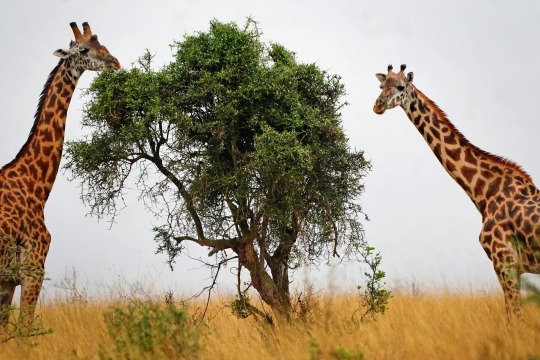
Two Giraffes graze on a tree in Nairobi National Park, Kenya. The park is just 7km south of the city but is home to more than 100 mammal species. Photograph: Victoria Jones/PA
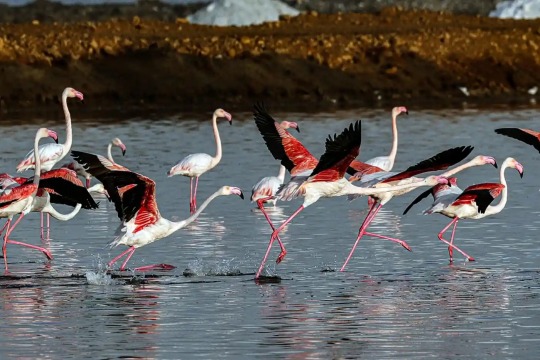
Wintering Flamingoes show off their stunning coloration at a nature reserve in Port Fouad, Egypt. Photograph: Xinhua/Shutterstock

A group of Chimpanzees listen to other chimpanzees heard at a distance in the West African Forests of Ivory Coast. This photo was provided by the Tai Chimpanzee Project, a research outfit set up in 1979 by two married primatologists who decided to study the animals’ reported habit of cracking nuts with tools. They found that not only did the chimps use ‘hammers’ but they would choose one made of wood or stone, depending on the hardness of the nut. Photograph: Roman M Wittig/Tai Chimpanzee Project/Reuters

An Adonis Blue Butterfly that has been discovered at Pyecombe Golf Course in West Sussex, UK. The golf course in the South Downs National Park has become a haven for butterflies after 34 species were discovered living in the rough, including rare species such as the adonis blue, brown hairstreak and grizzled skipper. Photograph: Neil Hulme/South Downs National Park Authority/PA
0 notes
Text
Events 10.7 (after 1950)
1950 – Mother Teresa establishes the Missionaries of Charity. 1958 – The 1958 Pakistani coup d'état inaugurates a prolonged period of military rule. 1958 – The U.S. crewed space-flight project is renamed to Project Mercury. 1959 – The Soviet probe Luna 3 transmits the first-ever photographs of the far side of the Moon. 1961 – A Douglas Dakota IV operated by Derby Aviation (later renamed to British Midland International) crashes in Canigou, France, killing 34 people. 1963 – President Kennedy signs the ratification of the Partial Nuclear Test Ban Treaty. 1963 – Buddhist crisis: Amid worsening relations, outspoken South Vietnamese First Lady Madame Ngo Dinh Nhu arrives in the US for a speaking tour, continuing a flurry of attacks on the Kennedy administration. 1977 – The Fourth Soviet Constitution is adopted. 1978 – Aeroflot Flight 1080 crashes after takeoff from Koltsovo International Airport, killing 38. 1979 – Swissair Flight 316 crashes at Ellinikon International Airport in Athens, Greece, killing 14. 1985 – The Mameyes landslide kills almost 200 people in Puerto Rico. 1985 – Four men from the Palestine Liberation Front hijack the MS Achille Lauro off the coast of Egypt. 1987 – Sikh nationalists declare the independence of Khalistan from India; it is not internationally recognized. 1987 – Fiji becomes a republic. 1988 – A hunter discovers three gray whales trapped under the ice near Alaska; the situation becomes a multinational effort to free the whales. 1991 – Croatian War of Independence: Bombing of the Banski Dvori in Zagreb, Croatia. 1993 – The flood of '93 ends at St. Louis, Missouri, 103 days after it began, as the Mississippi River falls below flood stage. 1996 – Fox News Channel begins broadcasting. 1998 – Matthew Shepard, a gay student at the University of Wyoming, is found tied to a fence after being savagely beaten by two young adults in Laramie, Wyoming. He dies five days later. 2000 – Israeli-Palestinian conflict: Hezbollah militants capture three Israeli Defense Force soldiers in a cross-border raid. 2001 – The U.S. invasion of Afghanistan begins with an air assault and covert operations on the ground, starting the longest war in American history. 2002 – The Space Shuttle Atlantis launches on STS-112 to continue assembly of the International Space Station. 2008 – Asteroid 2008 TC3 impacts the Earth over Sudan, the first time an asteroid impact is detected prior to its entry into earth's atmosphere. 2008 – Qantas Flight 72 experiences an in-flight upset near Learmonth, Victoria, Australia, injuring 112. 2016 – In the wake of Hurricane Matthew, the death toll rises to over 800. 2022 – 10 people die and 8 are injured in an explosion at petrol station in Creeslough. 2022 – Ales Bialiatski, along with two organisations; Memorial & Center for Civil Liberties are awarded the Nobel Peace Prize.
0 notes